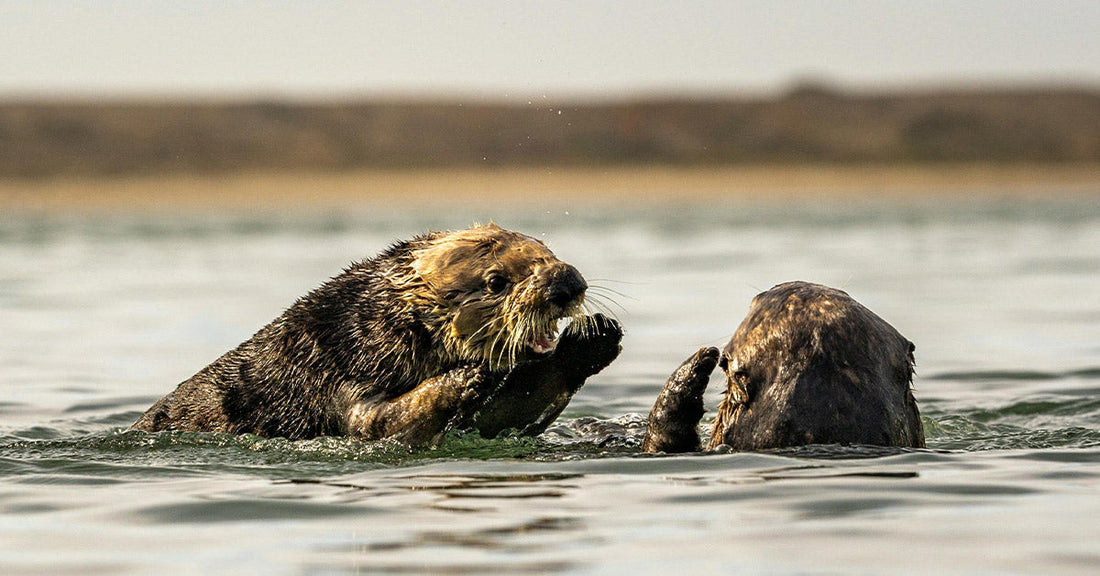7th Annual Holiday Toy & Book Event Help make the holidays brighter this year!
See How Otter Pups Depend on Mom’s Grip to Avoid Being Swept Away
Matthew Russell
In the open waters of the Pacific Ocean, a quiet yet striking behavior plays out among sea otters. Floating on their backs, they reach for one another’s paws. This isn’t just a charming sight—it’s a vital act of survival.
Hand-holding, or paw-holding, is a behavior primarily seen in sea otters, not their river or land-dwelling cousins. It allows them to form "rafts"—groups of two to several hundred individuals—that stay together as they rest on the waves.
Without it, ocean currents could separate them overnight, scattering family groups and leaving individuals vulnerable to predators or isolation, as Animals Around the Globe explains.

Sea otters hold hands to avoid drifting apart while sleeping.
Staying Afloat and Together
While it might resemble a sweet display of affection, the behavior is rooted in practicality. Sea otters live exclusively in marine environments and do not come ashore to sleep. Their dense fur, not blubber, keeps them warm—but only if it's clean and dry. Holding hands keeps the group stable in the surf and helps them conserve energy while maintaining body heat through proximity.
“Sea otters hold each other’s paws while floating in the open ocean to keep with the group and prevent themselves from drifting too far away,” A-Z Animals reports.
Mother otters take the practice even further. When a pup is too young to swim or float reliably, the mother will hold its paw while it sleeps on her chest or wrap it in seaweed before diving for food. This instinctive caregiving ensures that newborns don’t drift into danger—physically or emotionally untethered.

Otters use kelp as natural anchors in addition to hand-holding.
The Role of Kelp and Raft Size
Sea otters also use kelp as a natural anchor. They wrap themselves in the long strands that rise from the ocean floor to the surface, creating another layer of stability when hand-holding isn’t enough. These kelp forests not only protect otters from drifting but also benefit from the otters’ appetite for sea urchins, which, left unchecked, can decimate the ecosystem, Discover Magazine reports.
Rafts vary in size, sometimes numbering just a few otters, but sightings of 50 to 100 individuals are common. Super-rafts, composed of more than 200 otters, have even been spotted off the coast of Monterey, California. According to Glass Almanac, these larger groupings offer greater protection and warmth, and are a hopeful sign that sea otter populations may be recovering.

Only sea otters, not river otters, display this hand-holding behavior.
Not Just a Functional Gesture
Though the behavior is highly functional, it also has strong social elements. Sea otters are known to choose familiar individuals to raft with. Observations at the Seattle Aquarium and the Vancouver Aquarium show that bonded otters seek out specific partners for resting, reinforcing social cohesion within the group, The Dodo reports. Researchers speculate that paw-holding may reduce stress, much like touch does in other mammals.
Rafting is typically segregated by sex, and holding hands may play a role in maintaining social order within these gendered groups. In one study by the Monterey Bay Aquarium, sea otters were found to influence the health of kelp forests based on their population density, indicating that these close-knit social behaviors have far-reaching ecological effects.

Otter pups ride on their mothers until they can float independently.
Built to Grip
Physically, sea otters are well-equipped for hand-holding. Their dexterous forepaws, complete with retractable claws and sensitive pads, allow them to grasp each other, kelp, or even tools. They’re among the few animals known to use tools, often carrying a favorite rock in skin folds under their arms to crack open clams or mussels.
Anatomically, their paw structure mimics that of humans, with bones arranged for grip and manipulation. Neurologically, they’ve evolved heightened sensitivity in their forepaws, allowing them to coordinate delicate tasks—and gentle gestures like hand-holding—with precision, as Animals Around the Globe reports.
 Sea otters can form rafts of up to 1,000 individuals.
Sea otters can form rafts of up to 1,000 individuals.
A Species Still at Risk
Despite their popularity, sea otters remain at risk. Hunted nearly to extinction for their fur, their global population dropped below 2,000 by the early 20th century. Though now protected, threats like oil spills, climate change, and fishing gear entanglement still endanger their survival.
Current numbers hover around 3,000 for southern sea otters in California, far below historic levels. As Discover Magazine reports, their role as a keystone species means their loss could ripple through entire marine ecosystems.
More Than Just Adorable
To the casual observer, sea otters holding hands may seem like a heartwarming quirk. But this behavior is deeply embedded in their biology, shaped by environmental necessity and social complexity.
It’s a strategy to survive rough waters, protect the young, and stay close in an unpredictable world. It’s also a quiet act that invites human connection—and through that, support for the survival of this extraordinary marine species.

